小学英语六年级上册基础知识 整理
六上U1-U3知识清单
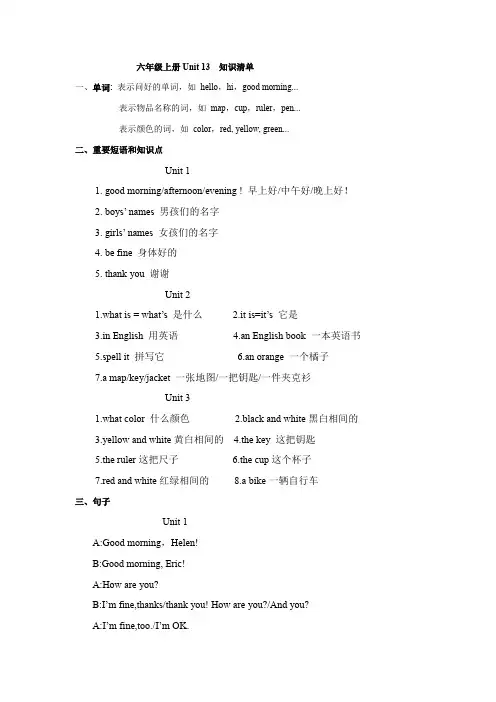
六年级上册Unit 13 知识清单一、单词: 表示问好的单词,如hello,hi,good morning...表示物品名称的词,如map,cup,ruler,pen...表示颜色的词,如color,red, yellow, green...二、重要短语和知识点Unit 11. good morning/afternoon/evening ! 早上好/中午好/晚上好!2. boys’ names 男孩们的名字3. girls’ names 女孩们的名字4. be fine 身体好的5. thank you 谢谢Unit 21.what is = what’s 是什么2.it is=it’s 它是3.in English 用英语4.an English book 一本英语书5.spell it 拼写它6.an orange 一个橘子7.a map/key/jacket 一张地图/一把钥匙/一件夹克衫Unit 31.what color 什么颜色2.black and white黑白相间的3.yellow and white黄白相间的4.the key 这把钥匙5.the ruler这把尺子6.the cup这个杯子7.red and white红绿相间的8.a bike一辆自行车三、句子Unit 1A:Good morning,Helen!B:Good morning, Eric!A:How are you?B:I’m fine,thanks/thank you! How are you?/And you?A:I’m fine,too./I’m OK.A:早上好,海伦!B:早上好,埃里克!A:你好吗?B:我很好,谢谢。
你呢A:我也很好。
Unit 2A:What’s this in English?B:It’s a jacket.A:What’s that in English?B:It’s an orange.A:Spell it,please.B:ORANGE.A:这个用英语怎么说?B:它是一件夹克衫。
六年级英语上册知识点总结
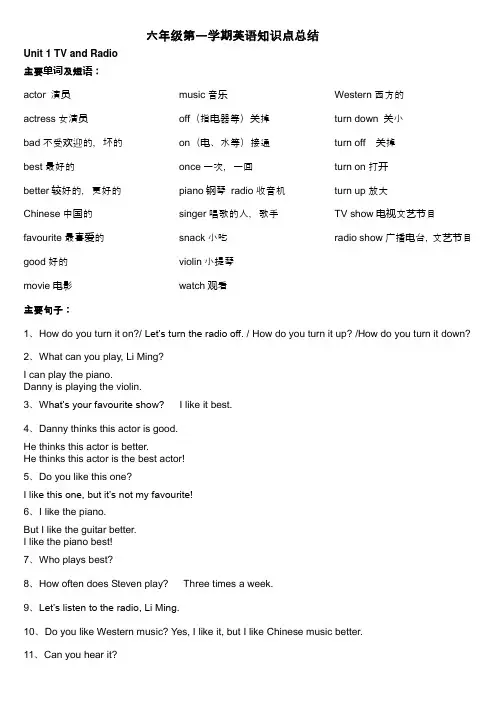
六年级第一学期英语知识点总结Unit 1 TV and Radio主要单词及短语:actor 演员actress女演员bad不受欢迎的,坏的best最好的better较好的,更好的Chinese中国的favourite最喜爱的good好的movie电影music音乐off(指电器等)关掉on(电、水等)接通once一次,一回piano钢琴radio收音机singer唱歌的人,歌手snack小吃violin小提琴watch观看Western西方的turn down 关小turn off 关掉turn on打开turn up放大TV show电视文艺节目radio show广播电台,文艺节目主要句子:1、How do you turn it on?/ Let’s turn the radio off. / How do you turn it up? /How do you turn it down?2、What can you play, Li Ming?I can play the piano.Danny is playing the violin.3、What’s your favourite show?I like it best.4、Danny thinks this actor is good.He thinks this actor is better.He thinks this actor is the best actor!5、Do you like this one?I like this one, but it’s not my favourite!6、I like the piano.But I like the guitar better.I like the piano best!7、Who plays best?8、How often does Steven play? Three times a week.9、Let’s listen to the radio, Li Ming.10、Do you like Western music? Yes, I like it, but I like Chinese music better.11、Can you hear it?12、Why is the radio playing Chinese music?13、Thanks for finding this radio show.14、Dinosaurs and people are different. I think dinosaurs and people are the same.15、What did you like best?I liked the dinosaur better than the rabbit, but I liked the snacks best.16、They order some food.17、Jenny wants Western food. “I would like a hamburger, French fries and milk, please.”18、I would like some Chinese food, please. I would like some noodles, dumplings and tea.19、There are many people at the restaurant.20、I can’t hear her. I can’t hear her either.重点语法复习:绝大多数形容词有三种形式,原级,比较级和最高级, 以表示形容词说明的性质在程度上的不同。
小学英语六年级上册知识清单

Unit 1 Growing up 一、我要掌握的词汇1.month一个月的时间;月份2.cute 可爱的3.pretty 漂亮的4.handsome英俊的;帅气的5.catch逮住;捕捉6.turtle 乌龟7.fly 苍蝇(flies 复数)8.grow up长大;成长9.junior high school 初级中学10.(be)born 出生11.primary school student小学生二、我要掌握的句型Her hair was short and her eyes were big.她的头发很短,她的眼睛很大。
拓展: (单数) is--was (复数)are--were1.He/She is...他/她是(一般现在)2.He/She will be...他/她将是··(一般将来)三、考点突破Her hair was short and her eyes were big.她的头发很短,她的眼睛很大。
(一般过去)解析:这是描写人物过去体貌特征的句型。
其句型结构为“主语+was/were++形容词.”。
当主语是I或第三人称单数时,be动词用was;其他情况 be动词用were。
例句:Mum,look at this photo. My hair was short then.妈妈,看这张照片。
那时我的头发很短。
四、如何写人物成长变化的小作文(一)、思维步骤1.确定时态。
此类短文是对比人物成长过程的变化,要用到两种时态:一般过去时和一般现在时。
2.我们在写的时候先选择一个小时候的片段用一般过去时来描述,然后用一般现在时介绍现在的情况,把两个不同的阶段进行对比。
(二)、精彩词句(三)、经典范文I was a cute boy when I was five years old. My hair was short and my eyes were big. I had a lot of toys. I also liked watching cartoons on TV. But now I am 11. I am tall now. I like playing football.I don't like to watch so many cartoons on TV. I like drawing cartoons now.当我5岁的时候我曾是个可爱的男孩。
小学六年级上册英语知识点归纳总结
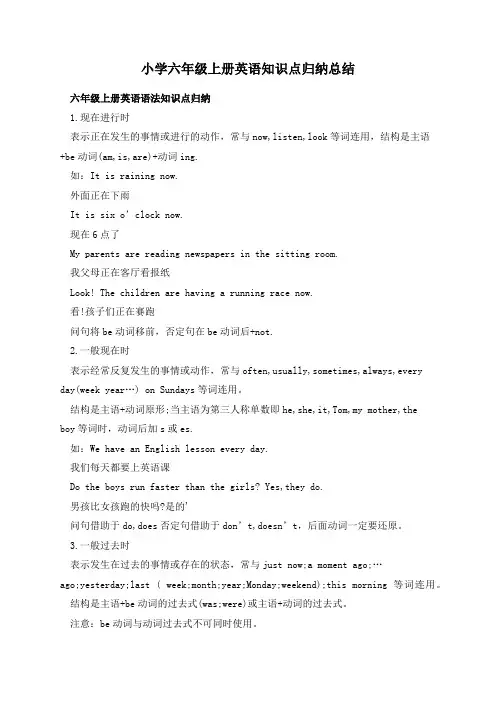
小学六年级上册英语知识点归纳总结六年级上册英语语法知识点归纳1.现在进行时表示正在发生的事情或进行的动作,常与now,listen,look等词连用,结构是主语+be动词(am,is,are)+动词ing.如:It is raining now.外面正在下雨It is six o’clock now.现在6点了My parents are reading newspapers in the sitting room.我父母正在客厅看报纸Look! The children are having a running race now.看!孩子们正在赛跑问句将be动词移前,否定句在be动词后+not.2.一般现在时表示经常反复发生的事情或动作,常与often,usually,sometimes,always,every day(week year…) on Sundays等词连用。
结构是主语+动词原形;当主语为第三人称单数即he,she,it,Tom,my mother,theboy等词时,动词后加s或es.如:We have an English lesson every day.我们每天都要上英语课Do the boys run faster than the girls? Yes,they do.男孩比女孩跑的快吗?是的'问句借助于do,does否定句借助于don’t,doesn’t,后面动词一定要还原。
3.一般过去时表示发生在过去的事情或存在的状态,常与just now;a moment ago;…ago;yesterday;last ( week;month;year;Monday;weekend);this morning等词连用。
结构是主语+be动词的过去式(was;were)或主语+动词的过去式。
注意:be动词与动词过去式不可同时使用。
如:My earphones were on the ground just now.我的耳机刚刚还在呢。
英语知识点六年级上册
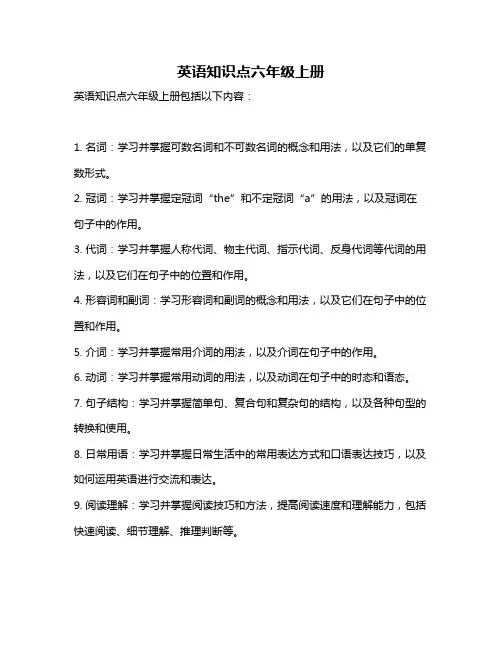
英语知识点六年级上册
英语知识点六年级上册包括以下内容:
1. 名词:学习并掌握可数名词和不可数名词的概念和用法,以及它们的单复数形式。
2. 冠词:学习并掌握定冠词“the”和不定冠词“a”的用法,以及冠词在句子中的作用。
3. 代词:学习并掌握人称代词、物主代词、指示代词、反身代词等代词的用法,以及它们在句子中的位置和作用。
4. 形容词和副词:学习形容词和副词的概念和用法,以及它们在句子中的位置和作用。
5. 介词:学习并掌握常用介词的用法,以及介词在句子中的作用。
6. 动词:学习并掌握常用动词的用法,以及动词在句子中的时态和语态。
7. 句子结构:学习并掌握简单句、复合句和复杂句的结构,以及各种句型的转换和使用。
8. 日常用语:学习并掌握日常生活中的常用表达方式和口语表达技巧,以及如何运用英语进行交流和表达。
9. 阅读理解:学习并掌握阅读技巧和方法,提高阅读速度和理解能力,包括快速阅读、细节理解、推理判断等。
10. 写作:学习并掌握写作技巧和方法,提高写作能力和表达能力,包括段落组织、篇章结构、语言表达等。
以上是英语知识点六年级上册的主要内容,通过学习和掌握这些知识点,可以帮助学生更好地理解和运用英语语言,提高英语水平和交际能力。
新版PEP小学英语六年级上册1-6单元知识点总结
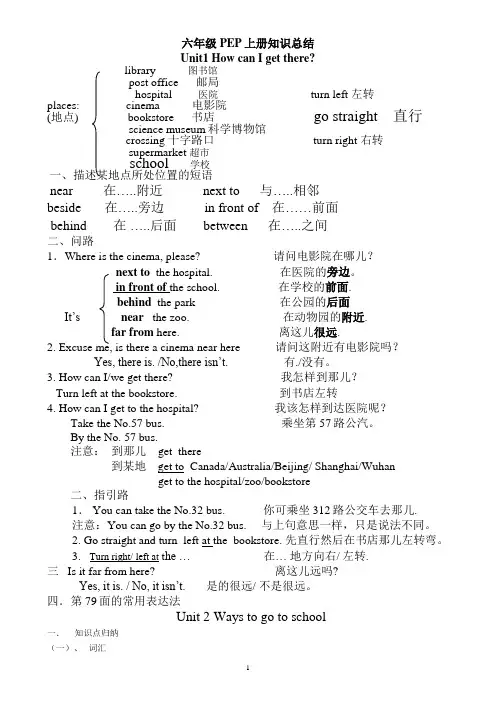
六年级PEP上册知识总结Unit1 How can I get there?library 图书馆post office 邮局hospital 医院turn left 左转places: cinema 电影院(地点) bookstore 书店go straight 直行science museum科学博物馆crossing 十字路口 turn right 右转supermarket 超市school 学校一、描述某地点所处位置的短语near 在…..附近 next to 与…..相邻beside 在…..旁边 in front of 在……前面behind 在…..后面 between 在…..之间二、问路1.Where is the cinema, please? 请问电影院在哪儿?next to the hospital. 在医院的旁边。
in front of the school. 在学校的前面.behind the park 在公园的后面It’s near the zoo. 在动物园的附近.far from here. 离这儿很远.2. Excuse me, is there a cinema near here 请问这附近有电影院吗?Yes, there is. /No,there isn’t. 有./没有。
3. How can I/we get there? 我怎样到那儿?Turn left at the bookstore. 到书店左转4. How can I get to the hospital? 我该怎样到达医院呢?Take the No.57 bus. 乘坐第57路公汽。
By the No. 57 bus.注意:到那儿 get there到某地 get to Canada/Australia/Beijing/ Shanghai/Wuhanget to the hospital/zoo/bookstore二、指引路1. You can take the No.32 bus. 你可乘坐312路公交车去那儿.注意:You can go by the No.32 bus. 与上句意思一样,只是说法不同。
小学英语六年级上册1-6单元知识点总结
六年级PEP上册知识总结Unit1How can I get there?library图书馆post office邮局hospital医院turn left左转turn right右转places:cinema电影院(地点)bookstore书店go straight直行science museum科学博物馆crossing十字路口supermarket超市school学校一、描述某地点所处位置的短语near在…..附近next to与…..相邻behind在…..后面beside在…..旁边in front of在……前面between在…..之间二、问路1.Where is the cinema,please?请问电影院在哪儿?next to the hospital.在医院的旁边。
in front of the school.在学校的前面.It’s behind the park在公园的后面near the zoo.在动物园的附近.far from here.离这儿很远.2.Excuse me,is there a cinema near here请问这附近有电影院吗?Yes,there is./No,there isn’t.有./没有。
3.How can I/we get there?我怎样到那儿?Turn left at the bookstore.到书店左转4.How can I get to the hospital?我该怎样到达医院呢?Take the No.57bus.乘坐第57路公汽。
By the No.57bus.注意:到那儿get there到某地get to Canada/Australia/Beijing/Shanghai/Wuhanget to the hospital/zoo/bookstore二、指引路1.You can take the No.32bus.你可乘坐312路公交车去那儿.注意:You can go by the No.32bus.与上句意思一样,只是说法不同。
六上英语重点知识归纳
六上英语重点知识归纳
以下是六年级英语上册的重点知识归纳:
1. 词汇:掌握六年级英语上册中的常用词汇,包括动物、数字、颜色、家庭成员等主题的词汇。
2. 语法:掌握简单现在时态的用法,包括动词be(am,is,are),动词have(has),以及一般现在时中的行为动词(如study,play等)。
3. 句型:掌握基本句型,如陈述句、疑问句和祈使句,以及简单现在时态的陈述句和疑问句。
4. 阅读理解:能够理解简单的英文短文,包括故事、科普文章等。
5. 写作:能够根据题目要求写简单的英文短文或故事,并注意语法和拼写的准确性。
6. 听力:能够听懂简单的英语对话和短文,并理解其中的主要信息。
7. 口语表达:能够用简单的英语进行口头表达,包括自我介绍、描述事物、表达观点等。
具体的知识点可能因教材版本和地区而有所不同,以上内容仅供参考。
如需更详细的内容,建议查阅英语教师或教材资料。
小学六年级英语上册知识点总结
小学六年级英语上册知识点总结1模一短语1 . more than 超过2 .twenty thousand kilometres long两万千米长3 .the Great Wall 长城4 .visit the US 参观美国5 .in New York 在纽约6 .look at 看7 .how long 多长8 .a picture of 一张…的照片9 .how big 多大 10 .has got/have got 有 11 .eight million people 八百万人口12 .twenty million people 两千万人口 13 .in the east of 在…的东部14 .in the west of 在…的西部 15 .in the south 在南部16 .in the north 在北部17 .the West Lake 西湖 18 .a map of 一张…的地图 19 .what about=how about 怎么样20 .in America 在美国 21 .every day 每天 22 .every night 每个晚上23 .right 同音词 write 24 .country 复数 countries 25 .an animal 一个动物二句子1 .It's more than twenty thousand kilometres long. 它超过两万千米长2 .He is in New York with his cousin Simon. 他和他的表哥西蒙一起在纽约3 .It is a picture of the the Great Wall. 它是一张长城的照片4 .Can you tell me something about New York?你能告诉我一些关于纽约的事吗?5 .It has got more than eight million people. 它有超过八百万人口6 .Beijing has got about twenty million people. 北京大约有两千万人口7 .It is in the west. 它是在西部8 .It's in the east of China. 它是在中国的东部9 .What a big map of the US!多么大的一张美国地图啊!2 模一短语1 .Chinese dancing 中国的舞蹈2 .any 用于否定句或一般疑问句中3 .in China 在中国4 .send an email 发送一封电子邮件5 .send sb sth=send sth to sb 给某人发送或邮寄某物6 .want sth 想要某物7 .want to do sth 想要做某事 8 .let's=let us 后加动词原形让我们9 .there 对应词 here 10 .the Changjiang River 长江11 .the Huangshan Mountain 黄山 12 .in the street 在大街上二句子1 .There is Chinese dancing. 有中国的舞蹈2 .There's a Chinatown in New York. 在纽约有一个唐人街3 .I'm sending an email to my family in China.我正在给我在中国的家人发送一个电子邮件4 .Do you want to go to Chinatown?你想要去唐人街吗?5 .Let's go to Chinatown. 让我们去唐人街吧6 .There are lots of beautiful lakes in China. 在中国有许多漂亮的湖7 .This is the famous Changjiang River. 这是著名的长江3模一词组1 .collect stamps 收集邮票2 .all of these stamps 所有的这些邮票3 .another Chinese stamp 另一张中国邮票4 .collect dolls 收集玩具娃娃6 .picture books 图画书7 .fly a kite=fly kites 放风筝8 .Chinese kites 中国的风筝9 .dragon kites 龙风筝 10 .ride a bike=ride bikes 骑自行车11 .play a game= play games 玩游戏 12 .collect toy cars 收集玩具汽车二句子1 .Collecting stamps is my hobby. 收集邮票是我的业余爱好2 .These are stamps from Canada. 这些是来自于加拿大的邮票3 .Have you got any stamps from China?你有一些来自于中国的邮票吗?4 .These stamps are from my letter. 这些邮票是来自于我的信5 .Is there a letter for me?有一封给我的信吗?6 .What's your hobby?你的爱好是什么?7 .Flying kites is my hobby. 放风筝是我的爱好8 .Taking pictures is my hobby. 拍照是我的爱好9 .Do you collect stamps?你收集邮票吗?4模一短语1 .my favourite festival 我最喜欢的节日2 .on Thanksgiving Day 在感恩节3 .on Flag Day 在国旗制定纪念日4 .fly the flag 升国旗5 .sing songs 唱国歌6 . after Thanksgiving dinner 感恩晚餐之后7 .American festival 美国的节目8 .have a special meal 吃一顿特殊的饭9 .on TV 在电视上10 .the Spring Festival 春节 11.eat moon cakes 吃月饼12 .at the Mid-Autumn Festival 在中秋节 13 .at the Dragon Boat Festival 在端午节14 .see the dragon boat race 看龙舟比赛 15 .hang lanterns 挂灯笼16 .do dragon dances 舞龙 17 .hang 过去式 hung二句子1 .Thanksgiving is my favourite festival. 感恩节是我最喜欢的节日2 .On Thanksgiving Day we say “thank you”for our food ,family and friend.在感恩节,我们对我们的食物,家人,朋友说谢谢你。
6年级上册英语重点知识
6年级上册英语重点知识
以下为6年级上册英语的重点知识:
1.词汇量扩展:6年级上册拓展了学生的词汇量,包括常见的名词、动词、形容词、副词等,以及一些常用的短语和习惯用语。
2.时态的使用:学生需要掌握一般现在时、一般过去时、一般将
来时等常用时态的基本使用规则和转换方法。
3.句子结构和语法:6年级上册学生需要了解和掌握一些基本的句型结构,如陈述句、疑问句、祈使句和感叹句等,同时了解一些基本
的语法规则,如主谓一致、形容词和副词的比较级和最高级等。
4.阅读技巧:学生需要学会通过阅读理解的方式获取信息,提高
阅读理解能力,如理解文章主题、推断问题答案、归纳概括等。
5.口语表达能力:学生需要通过对话、角色扮演等方式提高口语
表达能力,并学会用简洁明了的表达方式进行交流。
请注意,以上仅是六年级上册英语的一般知识点,具体的重点知识可能因教材和学校的不同而有所差异,请以实际教材和教学要求为准。
- 1、下载文档前请自行甄别文档内容的完整性,平台不提供额外的编辑、内容补充、找答案等附加服务。
- 2、"仅部分预览"的文档,不可在线预览部分如存在完整性等问题,可反馈申请退款(可完整预览的文档不适用该条件!)。
- 3、如文档侵犯您的权益,请联系客服反馈,我们会尽快为您处理(人工客服工作时间:9:00-18:30)。
小学英语六年级上册基础知识整理易混词整理can can’t cat cake kite mouse mouth能不能猫蛋糕风筝老鼠嘴meat meet thank think fine five肉遇见谢谢认为好的五you your Ms Mrs Miss Mr boy toy你你的女士夫人小姐先生男孩玩具and at too two door doll和在也二门玩具娃娃it’s its look book cook food foot它是它的看书烹饪食物足green grey/gray four for seven eleven绿色灰色是为,给七十一eight eat nine line twelve twenty八吃九线十二二十present parents say see ball tall礼物父母说看见球高的farmer father his he’s him head hand农民父亲他的他是他(宾格)头手in on under arm farm art her here 在……里/上/下手臂农场美术她的这里eye ear song some they them眼睛耳朵歌曲一些他们他们(宾格)pear bear who whose year ear梨熊谁谁的年耳朵work word spring bring cool cold工作字、词春季带来凉爽的冷的wind windy sun sunny snow snowy风有风的太阳晴朗的雪下雪的rain rainy bed bad sweater weather雨下雨的床坏的毛衣天气coat goat boat by buy close clothes外套山羊船乘(交通工具)买关上服装shirt skirt white write beside behind衬衫短裙白色写在......旁边在......后面tree train house horse thing think树火车房子马事情认为chess cheese far car bread break象棋奶酪远的小汽车面包破坏fruit foot ship sheep house horse水果足轮船羊房子马old cold will well wheel hair here hear her 老的冷的将好轮子头发这里听到她then than thin cloud cloudy housework homework 那么比瘦的云多云的家务劳动家庭作业everything everyone our or take talk所有事情所有人我们的或者带走谈话love live leave ride read wear where爱居住离开骑读穿哪里of for fourteen forty fifteen fifty ......的为,给十四四十十五五十floor four tea team time tie地板四茶运动队时间系上start star late let room zoo开始星星晚的让房间动物园now how last past grass class现在怎样上一个过草班级,课word world telephone television Chinese China词世界电话电视机中国的中国June July people pupil purple cook took六月七月人们小学生紫色烹饪带走(过去式)teach teacher drive driver say see sea教教师驾驶司机说看见海洋this these English England America American这个这些英国的,英语英国美国美国人,美国的dance dancer sing singer there those these跳舞舞蹈演员唱歌手那里那些这些race rice story sorry rule ruler比赛米饭故事对不起规则直尺cross close map cap sometimes something 穿过关上地图帽子有时某事物meal milk letter later cup cap一餐饭牛奶信过后杯子帽子wish which face fish nose nurse祝愿哪脸鱼鼻子护士语法知识整理一.时态二.加动词原形助动词:do,don’t, does, doesn’t,did,didn’t情态动词: can ,can’t, could, couldn’t, should,shouldn’t,must部分短语:want to, have to(不得不)三.a/an 用法绝大多数以元音字母(a,e,i,o,u)开头的单词都是用an,以辅音字母开头的都是用a。
an egg/ice cream / elephant/umbrella/apple/orange四.some 与anysome用于肯定句,any 用于否定句或一般疑问句e.g. I want some oranges. (肯定句)I don’t want any oranges.(否定句)Do you want any oranges?(一般疑问句)五.特殊疑问词Who Whose What Where Which Why谁谁的什么哪里哪一... 为什么How How many How much How old怎样多少(可数名词)多少(不可数名词),多少钱多少岁六.一般疑问句与特殊疑问句的区别首先,句子开头不一样,一般疑问句是以be动词,助动词(do,does,did等),或者情态动词(can,may等)开头,做yes/no 回答。
而特殊疑问句是以特殊疑问词(what、how等)开头,要作具体回答。
其次,特殊疑问句其实就是特殊疑问词加一般疑问句构成,比如:Do you go to school on foot?(一般疑问句)Why do you go to school on foot?(特殊疑问句)七.人称和物主代词八.九.名词复数规则1.一般情况下,直接加-s,如:book-books,bag-bags,cat-cats,bed-beds2.以s。
x。
sh。
ch结尾,加-es,如:bus-buses,box-boxes,brush-brushes,watch-watches3.以“辅音字母y”结尾,变y为i,再加-es,如:family-families,strawberry-strawberries4.以“f或fe”结尾,变f或fe为v,再加-es,如:knife-knives 〕5.不规则名词复数:man-men,woman-women,policeman-policemen,policewoman-policewomen,child-children foot-feet tooth-teethfish-fish,people-people,Chinese-Chinese,Japanese-Japanese十.动词的用法1、到目前为止,我们学过的be动词包括三个词am ,is, are 这三个词的汉语意思相同,都是"是"的意思,但怎么运用好这三个词呢?请记住下列口决:2、我是am eg:I am a pupil.3、你是are eg:You are a girl.4、Is 用在他、她、它eg:He is a Chinese boy,She is an English teather,It is acat.见到复数就用are.5、记住:am ,is 的复数是are.6、记住:these 这些;those 那些(这两个词都表示复数)十一.十二.动词过去式详解动词的过去式的构成规则有:A、规则动词①一般直接在动词的后面加ed:如worked , learned , cleaned , visited②以e结尾的动词直接加d:如lived , danced , used③以辅音字母加y结尾的动词要改y为i再加ed(此类动词较少)如study –studied carry –carried worry –worried (注意play、stay不是辅音字母加y,所以不属于此类)④双写最后一个字母(此类动词较少)如stoppedB、不规则动词(此类词并无规则,须熟记)小学阶段要记住以下动词的原形和过去式:sing –sang , eat –ate ,see –saw , have –had , do –did , go –went , take –took , buy –bought , get –got , read –read ,fly –flew , am/is –was ,are –were , say –said , leave –left , swim –swam , tell –told , draw –drew , come –came , lose –lost , find –found , drink –drank , hurt –hurt , feel –felt(3)一般将来时:基本结构:①be going to + do;②will+ do. be going to = willI am going to go swimming tomorrow(明天). = I will go swimming tomorrow.(4)现在进行时: am,is,are+动词现在分词动词现在分词详解动词的ing形式的构成规则:①一般的直接在后面加上ing , 如doing , going , working , singing , eating②以e 结尾的动词,要先去e再加ing ,如having , writing③双写最后一个字母的(此类动词极少)有:running , swimming , sitting , getting 十三.There be 句型与have, has的区别1、There be 句型表示:在某地有某物(或人)2、在there be 句型中,主语是单数,be 动词用is ; 主语是复数,be 动词用are ; 如有几件物品,be 动词根据最*近be 动词的那个名词决定。
3、there be 句型的否定句在be 动词后加not , 一般疑问句把be 动词调到句首。
4、there be句型与have(has) 的区别:there be 表示在某地有某物(或人);have(has) 表示某人拥有某物。
